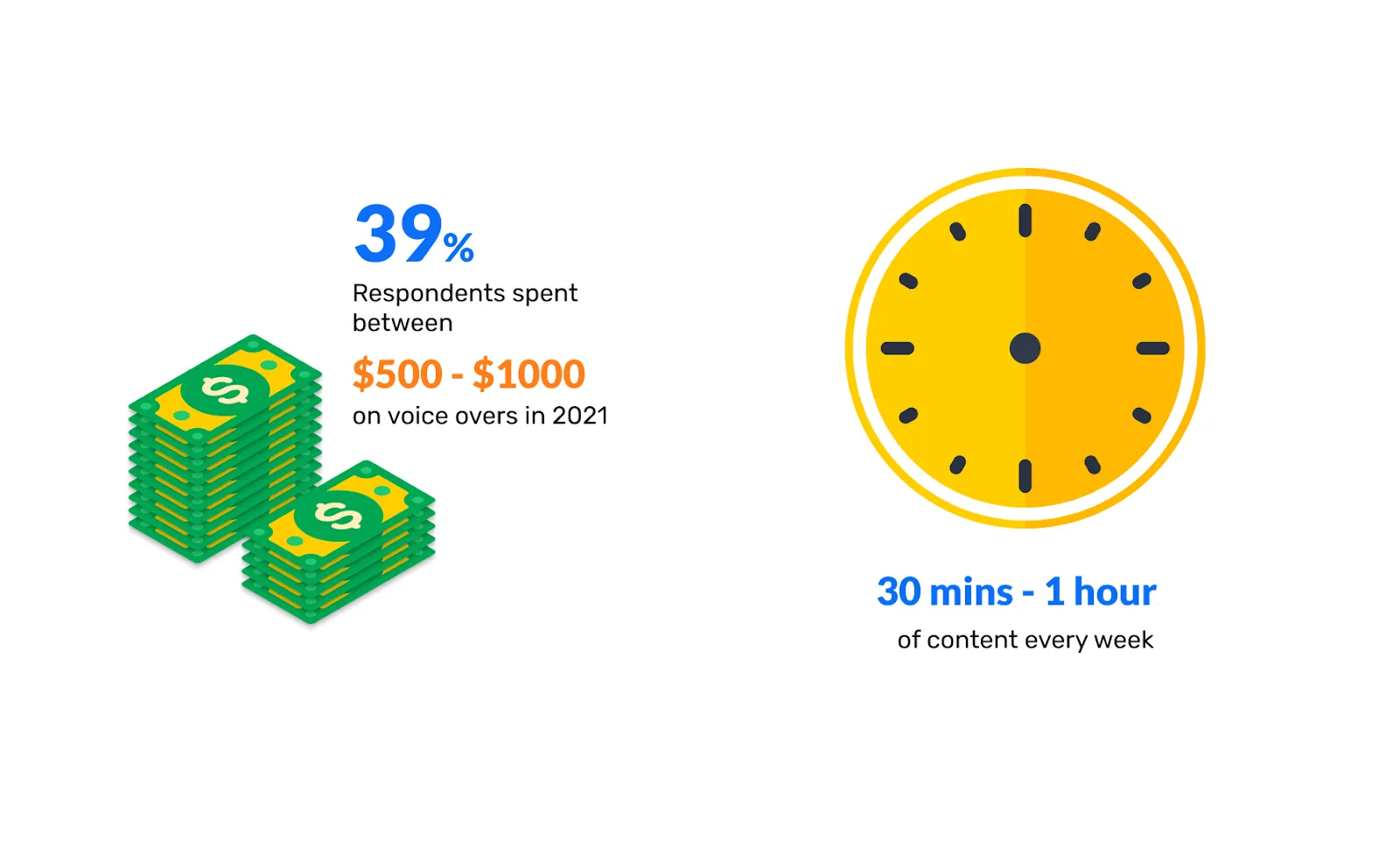5 Emerging Trends in the AI Voice Over Industry

To chart our future priorities in Voice AI innovation in 2022, we surveyed a select sample of professionals in marketing and education. They told us about their daily interactions with voices and AI voice generators and shared their growth outlook for the AI voice over industry. In this article, we map these findings to overall consumption patterns, user intentions towards the technology, and emerging trends in voice AI.
Adoption and awareness of AI voice technology
Voice overs are embedded in our lives.
Most of the respondents have encountered voice overs through customer service on the phone (74%), followed by voice assistants like Alexa, Siri and Hey Google (66%). As a further example of the explosive growth of creation and consumption of online video content, 63% said they have experienced voice overs through videos on platforms like YouTube. A healthy 25% said they have used or heard of text to speech players like Murf, and another 25% said that they know about voice actors and studio recorded voices.

The power of an emotive and well-articulated voice is reflected in the time and money spent on voice overs.
39% of our respondents spent between $500 and $1000 on voice overs in 2021, a sturdy share that showcases the need for quality audio beyond popular entertainment and media. Time, a precious, irreversible commodity that defines our productivity, and consequently, our success, has also been spent on creating multimedia content. On an average, 80% of our respondents created anywhere between 30 minutes and one hour of content every week in 2021.

Nearly everyone has heard of AI voices.
Today, everyone knows that the voice assistant, and the customer service support on the phone are not human voices. The synthetic voice has definitively moved out of its sci-fi world into ours. Awareness, the kickoff attribute of the consumption funnel in this industry is a whopping 94% for AI voices. Marketing professionals are ahead of their counterparts in education, with nearly all of them claiming to know about it.
Professionals used AI voice overs in their presentations, marketing videos, course modules and audio content.
Out of those who have heard of AI voice overs, a little more than a third have used them in their work. At 38%, this percentage is an indicator of the acceptance of AI voices in mainstream workflows. For example, most respondents said they used AI narrator voices for their presentations, followed by course modules.

Respondents are eager to explore AI voice over applications in the immediate future.
In the past two years, AI voices have broken out of their metal mould into a more realistic, application-oriented and investment-friendly space. 54% of our respondents said that they have either created more content, or have seen content created by others with AI voice overs in 2021 than in 2020. If you are a content creator, there is no time like now to explore options for AI voice overs. There are more realistic voices out there, and about 36% of the professionals who have used or experienced AI voice overs agree. As the 44% who said that they spent more money on AI voices in 2021 than the previous year are thinking, this is also an area that is likely to justify the future investments you make towards creating great content.
The playing field of voice AI
We surveyed 87 working professionals in the fields of marketing, sales, business development and education in the USA and Canada through an online questionnaire.
Our survey was designed to capture insights from respondents both as consumers of voice overs and multimedia content, as well as creators who use digital tools and have a primarily online audience. Interacting with computer generated voices in daily life, combined with using voice overs for work, forges a mental map of what constitutes a quality voice. For someone who hears Siri or Alexa speak multiple times a day, the natural intonation, pauses and depth of a human voice will feel pleasing and relaxing to the ears. Advancement is a moving goal in AI voice, and AI voices are closer to sounding more life-like than ever before. 37% of respondents who worked with voice overs in 2021 and have used studio recorded voices, also tried AI voices in their work.
Context specific insights enriched our findings
We included content types specific to marketing and elearning needs in our survey. Marketing videos are the prevalent form of digital advertising. They are short, punchy and to the point. Their primary goal is to entertain viewers long enough for them to absorb the marketing message. On the other hand, educational videos are explanatory in nature, and tend to be longer. They are conversational, usually accompanied by a screen with text or infographic images, and pack in a lot of content in a span of time.
More marketers utilised the expanded vocal database of AI voices
Marketing professionals were not only ahead in terms of awareness of AI voices technology, but also faster in adopting it in their work. This was reflected not only in the number of marketers who used it, but also in the affirmation that they spent more money on AI voices in 2021 than in 2020. 42% of marketing professionals who used voice overs in 2021 spent more money on AI voices. The corresponding percentage for elearning professionals is at 34%.

Educational content is script driven and rapidly catching up
At the same time, educationists who have heard of AI voice overs and used them expressed deeper involvement with the technology. Creating a course module is more time consuming than a 30 second marketing video. It also demands deeper involvement into the needs of the audience so as to keep them engaged the entire time. Almost overnight, the COVID-19 pandemic created a need for an online equivalent of a formal classroom. As teachers worldwide found out, an online class is very different from a physical one. 46% of professionals in education said they created more content with AI voice overs in 2021, than in 2020. Audio remains the primary form of imparting knowledge, and in AI voices, education professionals have found a tool that is as effective for 5 minutes, as it is for 50 minutes.
Implications for customers & opportunities for providers
Voice AI is visibly enhancing the quality of multimedia content
Similar to the popular adage that there is no smoke without fire, the ability of AI voices to improve the quality of the content output is a major reason for greater adoption. A voice over video where the voice serves to amplify the effect of the visual assets creates a consumption experience that is superior to a bulk of videos on the internet today. Well made content is better placed to perform when given more visibility, and so it can provide better returns on marketing monies. Better returns come from more impressions, definitely, but also from user engagement, a darling metric that is challenging to meet. AI in voice is about getting the best out of voice, methodically and strategically. The perfect mix of articulation and depth of emotion can transform a simple statement. The process of fine tuning this benefit through a dashboard has created new opportunities for companies to harness the growing power of sound. Sound infuses soul into content, right into consumers’ hearts, simply because of history. After all, life is said to have begun as a series of sounds.
Voice AI can become a widely accepted technology
Advancements in artificial intelligence are propelled by deep learning algorithms, technology growth and consumption patterns. In particular, voice AI has the potential to become a multiple-use, standard addition to any online content, because of two reasons:
- AI technology has improved voice quality to the extent that a synthetic voice sounds closer to a real human voice than ever before. Further, an AI voice over can be tweaked using everyday, understandable settings like pitch and tone, providing a clearly discernible difference in output.
- AI applications are, by their very nature, solutions powered by machine learning. This process has the capacity to scale exponentially at incremental cost, enabling service providers like Murf to offer superior experiences at affordable prices. To be persuaded, look no further than the measure of real change, in the next point.
Real impact is measured through palpable change in both output and intent
When asked to highlight what aspects of their work with AI voice overs have improved or changed in 2021 over the previous year, 44% said they spent more money on AI voice overs in 2021 than in 2020, and 54% also said that they had either seen more content or created more content themselves in 2021 than the previous year. Irrespective of whether they had heard of, or used AI voices, more than 90% of our respondents shared positive impressions of AI voice overs, cementing their need for a tech driven talent solution that meets their quality requirements while being global, scalable and reasonable on the pocket.




.webp)
.webp)
.webp)









